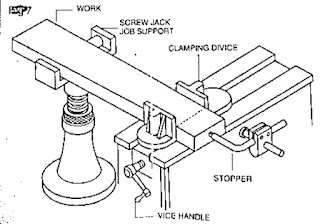Colouring of metals
.methods of colouring by heat
.different methods of colouring metals
. method of blackening /black oil finishing of metal surfaces
Machined or filled ferrous metal surfaces can be colored by the following methods.
Heating and cooling
Application of chemicals
Colouring by heating
Attractive colours can be given to metals by heating. In this process, the metal surface to be treated is thoroughly polished.
The metal is then placed in a heat treatment oven or flame heated.
During the heating of the metal, watch the colours as they appear.
When the desired colour is seen, remove and quench suddenly in water or oil.
Rub gently with steel wool.
Black oil finish
For blackening the surface of a ferrous metal, first clean the surface thoroughly, and apply a coating of thick lubricating oil.
Then heat the metal to 150° to 175° c for about 5 to 8 minutes.
This will give a black and rust preventing coating on ferrous metal surfaces.
Chemical colouring
Polished surfaces of iron and steel can be given the following colours by the application of certain chemicals.
Colour and process
BLUE BLACK
Process- Mix 16 parts of saltpetre and two parts of oxides of manganese. Heat the mixture to 400° c and dip the cleaned work in it. Keep the workpiece in the mixture and allow it to cool.
BROWN
Proces- Dip the workpiece in ammonia and dry in open air. Dip the work in hydrochloric acid and dry in warm place. Dip the workpiece in gallic acid and remove it when the desired colour is obtained.
BRONZE
Heat the workpiece slightly and paint a paste of antimony chloride. Watch for the desire shade to appear on the workpiece. Then wipe it dry.
CAUTION
Use hand gloves and goggles when working with chemicals.
Steel ( Plain carbon steel)
Steel is fundamentally an alloy of iron and carbon with the carbon content varying up to 1.5%. The carbon present is in a combained state.
Plain carbon steels are classified according to their carbon countent.
CLASSIFICATION AND CONTENT OF PLAIN CARBON STEEL
DEAD MILD STEEL
The percentage of carbon is 0.1 to 1.25%.
They high ductile. Used for making wire rods, thin sheets & solid drawn tubes.
MILD STEEL
The percentage of carbon is 0.15 to. 3%.
They relatively soft and ductile. Used for general workshop purposes,boiler plates, bridge work, structural sections and drop forgings.
MEDIUM CARBON STEEL
The percentage of carbon is 0.3 to 0.5%.
Used for making axles, drop forgings, high tensile tubes, wires and agricultural tool.
Medium carbon steel is carbon percentage different 0.5 to 0.7%.
This medium carbon steel is used for making steel,locomotive tyres, large forging dies, wire ropes, hammers and snaps for riveters
HIGH CARBON STEEL
High carbon steel is percentage of carbon 0.7 to 0.9% is used for making spring, small forging dies, shear blades and wood chisels.
High carbon steel percentage of carbon is 0.9 to 1.1%. It is used for making cold chisels, press dies, punches, wook working tools, axes etc.
High carbon steel percentage of carbon 1.1% to 1.4% is used for making hand files, drills, gauges, metal cutting tools,razors.




















